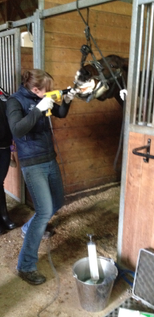Kelsey and I recently finished week four at Dundas Animal Hospital, and with that we are officially halfway finished our externship – I can’t believe how fast the time is flying! This week I had the opportunity to spend some more time with the large animal vets. The theme of this week seemed to be equine preventive care, which was right up my alley! We spent a considerable amount of time vaccinating horses and checking their teeth, floating them where required.
What do I mean when I say that we “float” horses’ teeth? “Floating” is a colloquial term used to describe the process of using rasps, or “floats”, to file down sharp parts on the teeth of horses. How do horses end up with sharp parts – called hooks and points – on their teeth, you may be wondering? Horses are in a category of animals called hypsodonts, because they have the type of teeth that have high crowns for extra wear and tear and their teeth will continually erupt over their lifetime.
Horses are grazing animals, designed to be eating forage nearly constantly, and this continuous chewing activity is what grinds down the teeth as they erupt. In the jaw of the horse, the upper jaw (maxilla) is slightly wider than the lower jaw (mandible) and this means that the outside (buccal) edges of the maxillary teeth and the inside (lingual) edges of the mandibular teeth are more likely to develop sharp points. The maxillary teeth also sit slightly forward compared to the mandibular teeth, which means that sharp hooks are more likely to develop at the upper front and lower back of the premolar/molar rows of teeth (arcades). These hooks and points are sharp and can rub on the cheeks and gums, causing painful ulcers that can make it difficult for horses to eat or wear a bridle to be ridden. Common signs that a horse is experiencing dental issues include: difficulty chewing; dropping food while eating (quidding); losing weight; and issues being ridden in a bridle with a bit, e.g. head tossing, unsteady head carriage, etc.
To remove these sharp hooks and points, veterinarians use floats, which look like giant nail files with a long handle. There are several types of floats and they can be divided into two categories: manual or hand floats, and power floats.
 Manual floats are powered by hand, and power floats are driven by electricity and look like a power tool. Veterinarians will typically sedate the horse, rinse out its mouth with water, apply an oral speculum to hold the mouth open for examination, and place the horse’s head in a dental halter or on a stand to hold it up. The veterinarian will then take a close look inside the horse’s mouth, and will feel around the mouth as well to check for any dental issues that may be difficult to see. In addition to hooks and points, horses may experience a variety of other dental issues including fractured or missing teeth or abnormal shape of the chewing (occlusal) surface of the teeth, etc. Some of these issues can be difficult to observe without using a speculum to see clearly inside the mouth.
Manual floats are powered by hand, and power floats are driven by electricity and look like a power tool. Veterinarians will typically sedate the horse, rinse out its mouth with water, apply an oral speculum to hold the mouth open for examination, and place the horse’s head in a dental halter or on a stand to hold it up. The veterinarian will then take a close look inside the horse’s mouth, and will feel around the mouth as well to check for any dental issues that may be difficult to see. In addition to hooks and points, horses may experience a variety of other dental issues including fractured or missing teeth or abnormal shape of the chewing (occlusal) surface of the teeth, etc. Some of these issues can be difficult to observe without using a speculum to see clearly inside the mouth.
The veterinarian will then proceed with floating to wear down the sharp hooks and points if there are any present, and will also treat any other dental problems they notice on their exam. An annual oral examination by your veterinarian is the best way to manage and prevent dental issues in your horse, and ensure that they are happy and healthy and able to eat properly!
If you would like more information on equine dentistry, please visit this website.
In this photo: A veterinarian uses a power float to rasp down sharp points and hooks on a horse’s teeth. The horse has been sedated, and is wearing an oral speculum to hold his mouth open. He is also wearing a dental halter hanging from the top of the stall to hold his head up so the veterinarian can easily see into his mouth for the oral examination and floating. The entire procedure typically takes 15 to 30 minutes from the time the horse is given sedation to when the floating is complete, depending on how much work is needed in the mouth.
